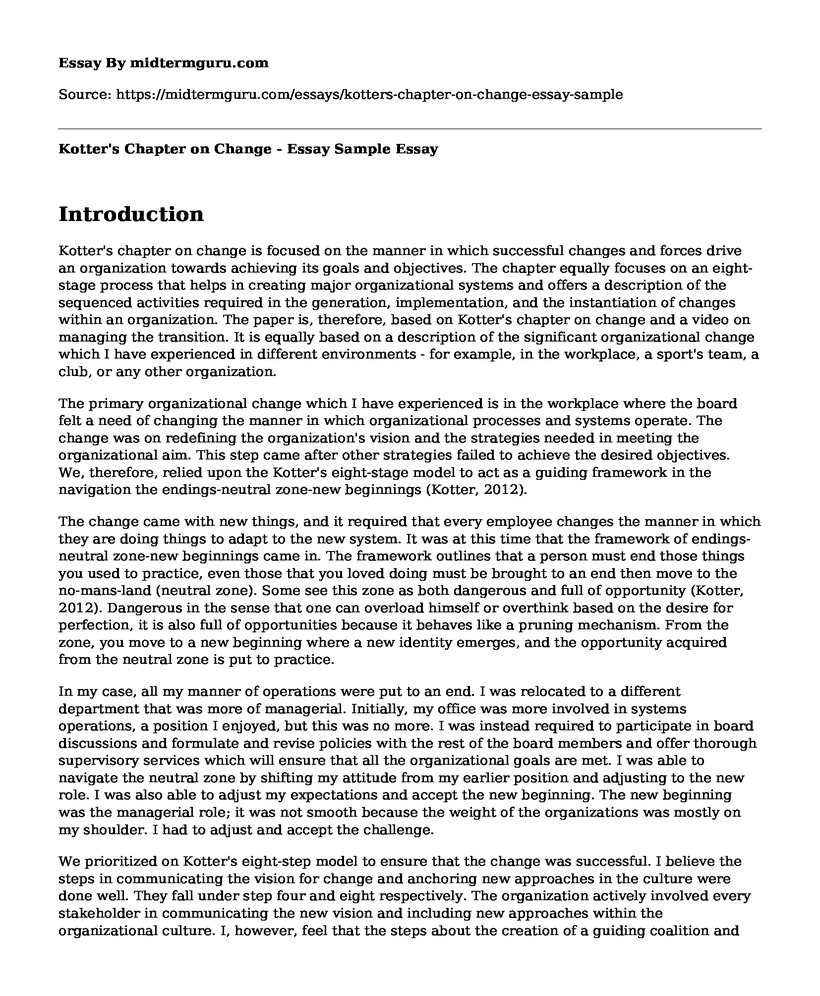Introduction
Kotter's chapter on change is focused on the manner in which successful changes and forces drive an organization towards achieving its goals and objectives. The chapter equally focuses on an eight-stage process that helps in creating major organizational systems and offers a description of the sequenced activities required in the generation, implementation, and the instantiation of changes within an organization. The paper is, therefore, based on Kotter's chapter on change and a video on managing the transition. It is equally based on a description of the significant organizational change which I have experienced in different environments - for example, in the workplace, a sport's team, a club, or any other organization.
The primary organizational change which I have experienced is in the workplace where the board felt a need of changing the manner in which organizational processes and systems operate. The change was on redefining the organization's vision and the strategies needed in meeting the organizational aim. This step came after other strategies failed to achieve the desired objectives. We, therefore, relied upon the Kotter's eight-stage model to act as a guiding framework in the navigation the endings-neutral zone-new beginnings (Kotter, 2012).
The change came with new things, and it required that every employee changes the manner in which they are doing things to adapt to the new system. It was at this time that the framework of endings-neutral zone-new beginnings came in. The framework outlines that a person must end those things you used to practice, even those that you loved doing must be brought to an end then move to the no-mans-land (neutral zone). Some see this zone as both dangerous and full of opportunity (Kotter, 2012). Dangerous in the sense that one can overload himself or overthink based on the desire for perfection, it is also full of opportunities because it behaves like a pruning mechanism. From the zone, you move to a new beginning where a new identity emerges, and the opportunity acquired from the neutral zone is put to practice.
In my case, all my manner of operations were put to an end. I was relocated to a different department that was more of managerial. Initially, my office was more involved in systems operations, a position I enjoyed, but this was no more. I was instead required to participate in board discussions and formulate and revise policies with the rest of the board members and offer thorough supervisory services which will ensure that all the organizational goals are met. I was able to navigate the neutral zone by shifting my attitude from my earlier position and adjusting to the new role. I was also able to adjust my expectations and accept the new beginning. The new beginning was the managerial role; it was not smooth because the weight of the organizations was mostly on my shoulder. I had to adjust and accept the challenge.
We prioritized on Kotter's eight-step model to ensure that the change was successful. I believe the steps in communicating the vision for change and anchoring new approaches in the culture were done well. They fall under step four and eight respectively. The organization actively involved every stakeholder in communicating the new vision and including new approaches within the organizational culture. I, however, feel that the steps about the creation of a guiding coalition and the generations of short-term wins could have been done a little better. These issues fall under step two and six respectively. The organization did not offer much priority to the guiding coalition, an issue which interfered with matters pertaining oversight (Pollack & Pollack, 2015). The generation of short-term wins was also not well coordinated, and to some extent stagnated the achievement of the objectives.
Conclusion
In summary, Kotter's chapter for change provides the eight-stage model which offers a framework on the way in which changes can be initiated within organizations while also assisting in the navigation of the endings-neutral zone-new beginnings. It is the same model that assisted me in taking my new managerial role during a major change in my workplace as noted in the body.
References
Kotter, J. P. (2012). Leading change. Harvard business press.
Pollack, J., & Pollack, R. (2015). Using Kotter's eight-stage process to manage an organizational change program: Presentation and practice. Systemic Practice and Action Research, 28(1), 51-66.
Cite this page
Kotter's Chapter on Change - Essay Sample. (2022, Nov 04). Retrieved from https://midtermguru.com/essays/kotters-chapter-on-change-essay-sample
If you are the original author of this essay and no longer wish to have it published on the midtermguru.com website, please click below to request its removal:
- Evaluation Essay on Jagerbull
- Letter From Manager of Sagami Tei Restaurant
- You Deserve A Break Today - Advertisement Essay Sample
- Human Service Research Institute - Essay Sample
- Theory of Constraints (TOC) - Essay Sample
- Essay Sample on Steelcase: From Wooden to Metal Furniture 1912-Present
- Able Electronics: Sensors For Detecting Environmental Changes - Essay Sample







